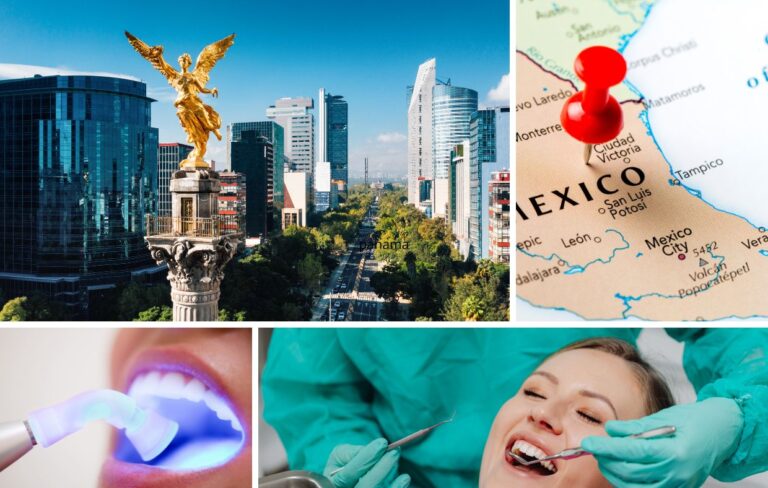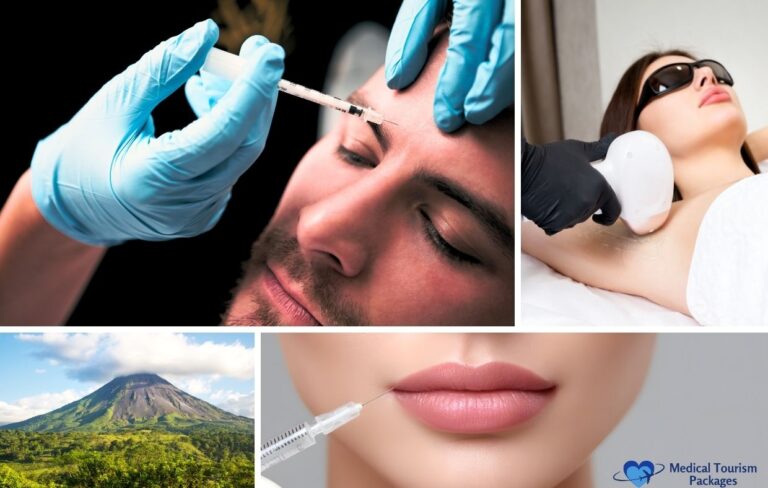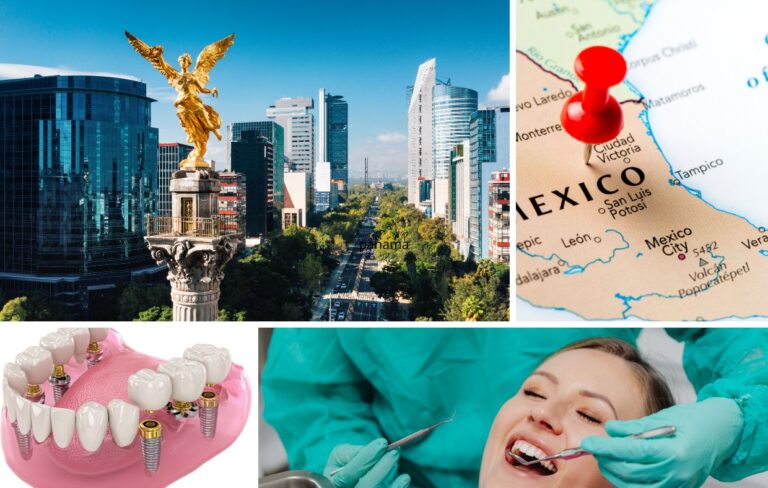Book Appointment Now
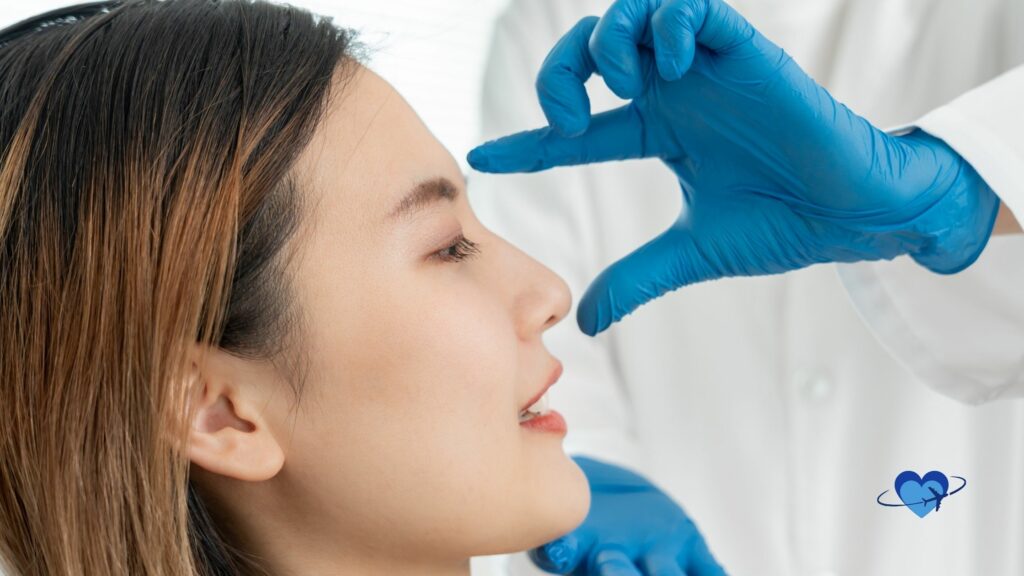
Rhinoplasty (Nose Job) in Colombia: Surgery, Recovery, Results
Rhinoplasty in Colombia delivers natural-looking results at 50-70% lower costs than the US, performed by SCCP-certified surgeons trained in both aesthetic and functional nose surgery.
A nose job in Colombia costs $2,000-$4,000 versus $8,000-$15,000 in the US. Board-certified surgeons in Bogotá, Medellín, and Cali perform 50,000+ rhinoplasty procedures annually using advanced techniques like ultrasonic rhinoplasty.
Our network connects you with SCCP-certified rhinoplasty specialists across Colombia’s top medical cities—each verified for credentials, before/after portfolios, and patient outcomes. Below, you’ll find procedure details, recovery timelines, cost breakdowns, and surgeon profiles.
What Is Rhinoplasty Surgery in Colombia?
Rhinoplasty in Colombia is surgery that changes the nose’s shape or function. Surgeons in Bogotá and Medellín perform two types: cosmetic and functional. Cosmetic rhinoplasty improves appearance. Functional rhinoplasty fixes breathing problems.
The surgery uses two main techniques. Closed rhinoplasty hides all incisions inside the nostrils. Open rhinoplasty makes a small cut on the columella for complex cases. Both methods reshape bone and cartilage to achieve your goals.
Colombian Society of Plastic Surgery members follow strict standards. Most patients see initial results when bandages come off after 7-10 days. Final results appear within 6-12 months as swelling fully subsides.
What Types of Nose Jobs Are Available?
How Is a Crooked Nose Corrected?
A crooked nose is corrected through straightening techniques. Surgeons in Medellín and Bogotá fix bent or twisted noses from injury or genetics. The goal is natural, balanced results.
What Is Non-Surgical Rhinoplasty?
Non-surgical rhinoplasty is a quick 15-minute procedure using dermal fillers. It’s ideal for minor adjustments without surgery or downtime. Results last 12-18 months.
What Is the Difference Between Primary and Secondary Rhinoplasty?
- Primary: Your first nose job surgery
- Secondary: Revision surgery to improve previous results (15% of patients need this)
What Is Ultrasonic Rhinoplasty?
Ultrasonic rhinoplasty uses piezoelectric technology to reshape bone with precision. Surgeons in Bogotá and Medellín use this advanced method. Benefits include:
- 50% less bruising and swelling
- Faster recovery (7-10 days vs 14-21 days)
- More precise bone sculpting
- Reduced trauma to surrounding tissues
How Much Does Rhinoplasty Cost in Colombia?
Rhinoplasty in Colombia costs $2,000-$4,000. This is 50-70% less than US prices of $8,000-$15,000. The final cost depends on surgeon experience, procedure complexity, and the facility you choose.
Surgeons in Bogotá, Medellín, and Cali offer competitive rates. You get the same quality as US surgeons at a fraction of the price. The savings cover your entire trip with money left over.
What Are the Base Surgery Costs?
The base surgery costs vary by procedure type. Here’s how Colombia compares to the US:
| Procedure Type | Colombia Cost | US Cost | Savings |
|---|---|---|---|
| Primary Rhinoplasty | $2,000-$3,500 | $8,000-$12,000 | 65-75% |
| Secondary Rhinoplasty | $3,000-$4,500 | $12,000-$18,000 | 70-80% |
| Non-Surgical | $300-$600 | $1,000-$2,000 | 60-70% |
| Ultrasonic Technique | $3,500-$4,000 | $15,000-$20,000 | 75-80% |
What Additional Costs Should You Budget?
You should budget for travel and recovery expenses beyond surgery fees. Plan for these additional costs:
- Flights: $300-$800 (depending on origin)
- Meals: $20-40/day
- Extended stay: $50-80/night
Many clinics in Bogotá and Medellín offer packages that bundle surgery with accommodations. These packages simplify your planning and often provide better value.
Meet Our Rhinoplasty Specialists in Colombia
Our network includes SCCP-certified surgeons trained in both aesthetic and functional rhinoplasty, including revision procedures.
Featured Rhinoplasty Surgeons
- Dr. Johnatan Guevarra – Over 5,000 procedures performed. SCCP and ASPS member. Specializes in rhinoplasty with natural-looking results. Based in Colombia.
- Dr. Darío Fernández Loaiza – SCCP-certified surgeon based in Bogotá. Specializes in facial procedures including rhinoplasty and blepharoplasty. Trained at Universidad del Rosario and FUCS.
- Dr. Alex Campbell & Carolina Restrepo – US-trained plastic surgeons at Premium Care. Experienced in rhinoplasty and facial procedures. Based in Cartagena.
→ View all our plastic surgeons in Colombia
What Are the Benefits of Rhinoplasty?
The benefits of rhinoplasty include both aesthetic and functional improvements. The surgery can fix a crooked nose, reduce a bump, or refine the tip. It can also correct breathing problems from a deviated septum.
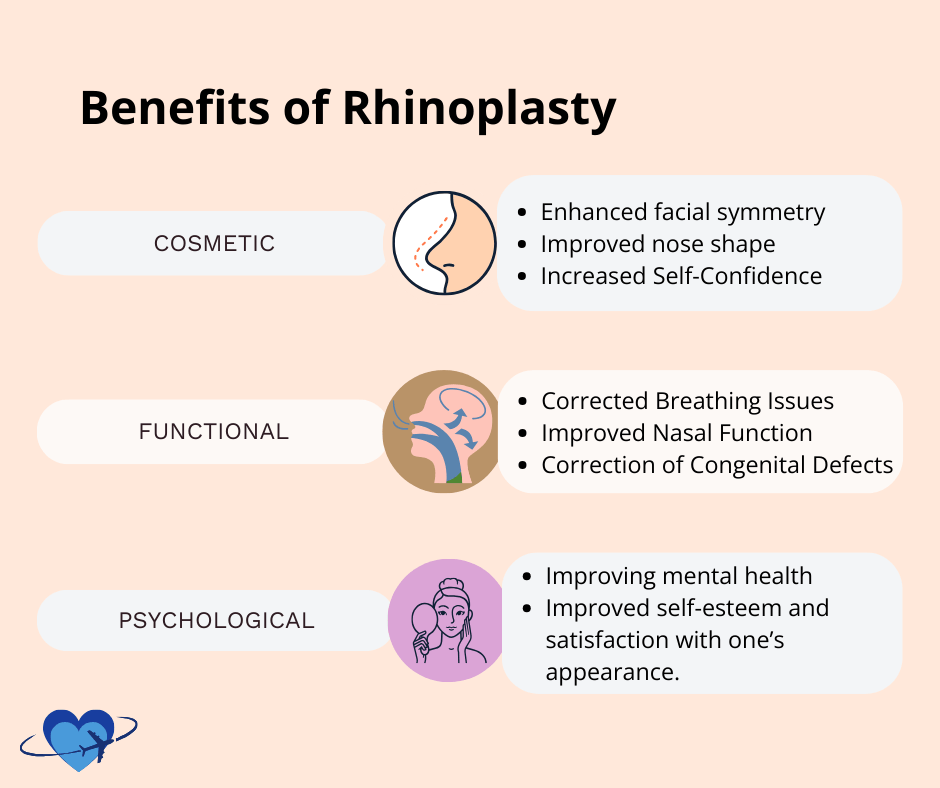
Many patients report higher self-confidence after surgery. The results look natural when done by skilled surgeons in Bogotá or Medellín. Advanced techniques like ultrasonic rhinoplasty mean faster recovery times.
| Benefit Type | Specific Improvement | Details |
| Cosmetic | Enhanced Facial Symmetry | Adjusting the nose to be more proportional to other facial features, improving overall facial balance. |
| Cosmetic | Improved Nose Shape | Reshaping the nose to a more desired appearance, such as straightening, reducing, or increasing the size. |
| Cosmetic | Increased Self-Confidence | Boosting the individual’s confidence and satisfaction with their appearance. |
| Functional | Corrected Breathing Issues | Addressing structural issues like a deviated septum to improve airflow and ease breathing. |
| Functional | Improved Nasal Function | Enhancing the overall functionality of the nose, including better airflow and possibly reducing snoring. |
| Functional | Correction of Congenital Defects | Fixing birth defects that affect the nose’s appearance and function. |
| Psychological | Enhanced Well-being | Improving mental health through increased self-esteem and satisfaction with one’s appearance. |
What Are the Aesthetic Benefits?
The aesthetic benefits include a more balanced nose that fits your face. Surgeons in Cali and Bogotá adjust size, shape, and position for natural results. Ultrasonic rhinoplasty creates precise changes with less bruising.
What Are the Functional Benefits?
The functional benefits include better breathing and improved sleep. Surgery can fix a deviated septum or nasal blockages. Many patients report reduced snoring after the procedure. Health insurance sometimes covers functional rhinoplasty.
How Do You Choose the Right Surgeon in Colombia?
You can choose the right surgeon by checking credentials and experience. Look for board certification from the Colombian Society of Plastic Surgery (SCCP). Review before-and-after photos and patient testimonials on RealSelf.
Surgeons in Bogotá and Medellín often hold dual memberships with international bodies. These include ASPS and ISAPS. This shows commitment to global standards.
Schedule a virtual consultation to discuss your goals. A good surgeon will set realistic expectations. They should explain risks and show examples of similar cases they’ve performed.
Learn more about our rhinoplasty procedure in Latin America.
Why Are Certification and Experience Important?
Certification and experience are important because they ensure safety and quality. Board certification means the surgeon passed rigorous assessments. Experience with many rhinoplasty procedures shows skill and adaptability.
Board-certified surgeons in Colombia maintain high standards. They follow strict protocols and continue their education. This is why Colombia attracts patients seeking high-quality cosmetic surgery.
How Is Rhinoplasty Performed in Colombia?
Rhinoplasty is performed by reshaping the nose’s bone and cartilage. The process starts with a consultation in Bogotá, Medellín, or Cali. Your surgeon will assess your nasal structure and discuss your goals.
What Happens During the Pre-Operative Assessment?
During the pre-operative assessment, the surgeon evaluates your nasal structure. They discuss desired changes and plan the best approach. This consultation determines if open or closed rhinoplasty is right for you.
The surgery typically takes 1-3 hours depending on complexity. You’ll see about 80% of results within 12 days. Full results take 6-12 months to appear.
What Are the Primary Rhinoplasty Techniques?
The primary rhinoplasty techniques are open and closed approaches:
- Closed Rhinoplasty: All incisions are inside the nostrils. There are no visible scars. This method reduces swelling and speeds recovery. Many surgeons in Bogotá prefer this technique.
- Open Rhinoplasty: A small incision is made on the columella. This allows better visibility for complex cases. Surgeons in Medellín use this for major changes or revisions.
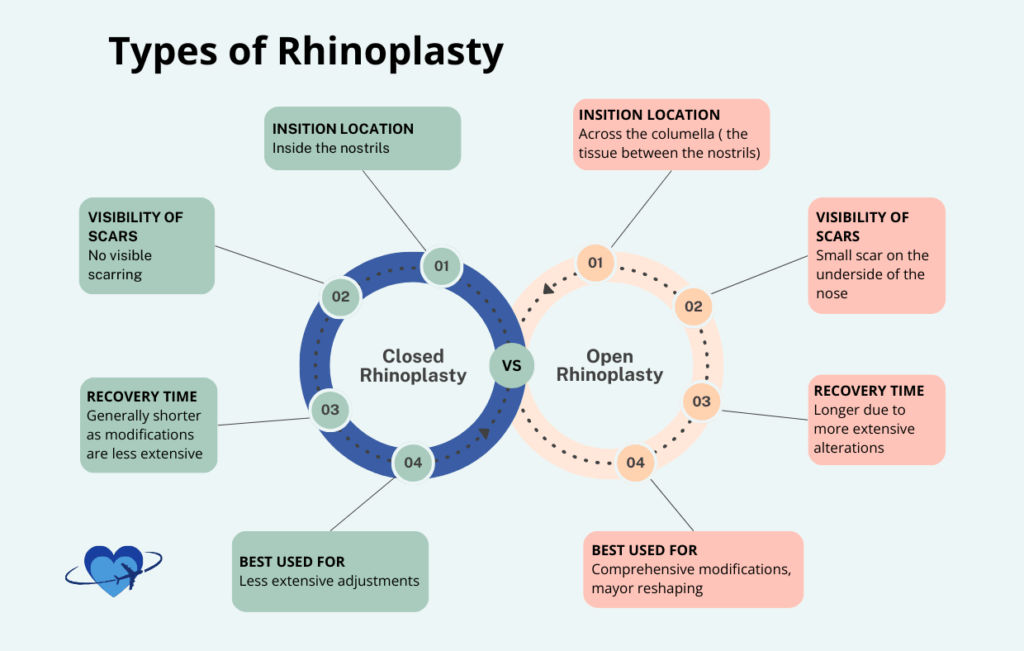
What Are the Anesthesia Options?
The anesthesia options are local or general. Most surgeons prefer general anesthesia for patient comfort and safety. Minor procedures like tip-plasty may only need local anesthesia. Your surgeon will recommend the best option.
What Are the Steps of Nose Job Surgery?
The steps of nose job surgery follow a clear sequence. First, the anesthesiologist administers anesthesia. Then the surgeon makes incisions inside the nostrils or on the columella.
Next, the surgeon lifts the soft tissues. They reshape the bone and cartilage underneath. Grafts may be used to refine shape. Finally, sutures close the incisions and a splint protects the nose.
What Is the Recovery Process for Rhinoplasty?
The recovery process for rhinoplasty takes 3-4 weeks for most patients. You can return to normal activities within 1-2 weeks. Initial swelling and bruising fade within 14 days. Complete healing takes up to 12 months.
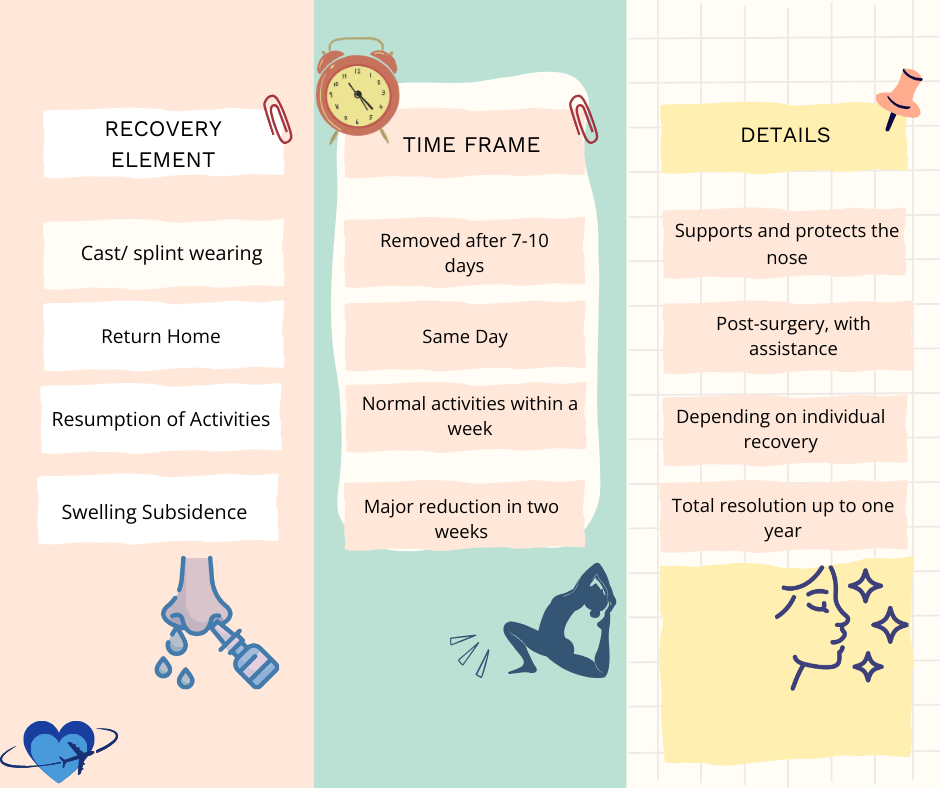
Recovery houses in Medellín and Bogotá provide 24/7 nursing support. You’ll go home the same day with a nasal splint. The splint comes off after 7-10 days.
| Phase/Activity | Timeframe | Guidance |
| Return Home | Same day | Post-surgery, with assistance |
| Cast/Splint | 7-10 days | Supports and protects the nose |
| Resting Position | Days 1-7 | Keep head elevated above heart level |
| Sleeping | Days 1-14 | Sleep on your back with head raised |
| Medications | As prescribed | Follow instructions; avoid NSAIDs |
| Physical Activity | Week 1+ | Avoid strenuous activities and heavy lifting |
| Nasal Care | Ongoing | Avoid blowing nose; follow cleaning instructions |
| Resume Activities | ~1 week | Depending on individual recovery |
| Major Swelling Gone | 2 weeks | Total resolution up to one year |
What Is Immediate Post-Operative Care?
Immediate post-operative care focuses on rest and head elevation. Keep your head above your heart to reduce swelling. Apply cold compresses to your cheeks. Avoid blowing your nose.
Your surgeon will prescribe pain medication. Avoid NSAIDs like ibuprofen as they increase bleeding risk. Antibiotics prevent infection. Recovery houses in Bogotá provide nursing care during this phase.
What Is the Complete Recovery Timeline?
What Happens During Days 1-3?
During days 1-3, you’ll experience the most discomfort. Expect mild pain, nasal congestion, and bruising around the eyes.
- Expect: Mild discomfort, nasal congestion, bruising around eyes
- Activities: Rest with head elevated, no strenuous activity
- Care: Apply ice packs, take prescribed medications
- Breathing: Mouth breathing normal due to nasal splint
What Happens During Days 4-7?
During days 4-7, swelling peaks then starts to decrease. You can begin light walking.
- Expect: Swelling peaks then starts decreasing
- Activities: Light walking, work from home possible
- Milestone: Splint and sutures removed (day 7-10)
What Happens During Weeks 2-4?
During weeks 2-4, about 80% of swelling is gone. You can resume most daily activities.
- Expect: 80% of swelling gone, visible results emerging
- Activities: Resume most daily activities, light exercise
- Appearance: Nose shape becoming more defined
What Happens During Months 1-6?
During months 1-6, your results continue to refine. You can return to all normal activities including sports.
- Expect: Gradual refinement of results
- Activities: All normal activities including sports
- Follow-up: Regular check-ins with surgeon
What Happens at Month 12?
At month 12, you see your final results. Complete healing is achieved with no restrictions.
- Activities: No restrictions
- Expect: Complete healing, final nose shape achieved
How Do You Manage Pain and Discomfort?
You can manage pain and discomfort with prescribed medications. General anesthesia keeps you comfortable during surgery. After surgery, most patients report minimal pain. Rest and head elevation reduce swelling. Bruising around the eyes fades within 1-2 weeks.
What Are the Risks and Considerations?
The risks include bleeding, infection, and reactions to anesthesia. Some patients experience nasal obstruction. Choosing an experienced surgeon in Bogotá or Medellín reduces these risks significantly.
Post-operative care is essential for good results. Avoid direct sun exposure and shocks to the nose. Follow all medication instructions. Final results take up to 12 months to fully settle.
What Are Common Complications?
Common complications include nosebleeds and temporary numbness. Small blood vessels may burst during healing. Scarring at the nose’s base is possible but usually minimal. About 5-15% of patients need revision surgery.
| Risk or Complication | Estimated Frequency | Notes |
| Bleeding | 1-5% | Minor bleeding is common, but significant bleeding requiring intervention is rare. |
| Infection | Less than 2% | Rhinoplasty has a lower infection rate compared to other surgeries, due to the rich blood supply to the face. |
| Adverse Reaction to Anesthesia | Varies | Risk depends on the type of anesthesia used and patient health. Pre-operative screenings help minimize this risk. |
| Swelling and Bruising | Nearly 100% (Swelling), 85-90% (Bruising) | Swelling is universal, while bruising varies. Both typically subside significantly within the first two weeks. |
| Difficulty Breathing | 1-10% | Often temporary; permanent issues are rare and may require revision surgery. |
| Loss of Smell | Less than 1% | Usually temporary, with most patients regaining this sense within weeks to months post-surgery. |
| Dissatisfaction with Aesthetic Outcome | 10-15% | Includes issues with asymmetry or not achieving the desired look. May lead to revision surgery. |
| Scarring | Less than 1% (Visible Scarring) | Open rhinoplasty may leave a small scar at the base of the nose, which typically fades over time. |
| Need for Revision Rhinoplasty Surgery or secondary rhinoplasty | 5-15% | Due to aesthetic dissatisfaction or functional issues not addressed in the initial surgery. |
What Factors Affect Surgery Success?
The factors that affect surgery success include surgeon skill and realistic expectations. Balance aesthetic goals with functional needs. Choose a surgeon who understands your facial features. The surgical technique also matters for recovery time and scarring.
What Results Can You Expect from Rhinoplasty?
You can expect a refined nose shape that fits your face. The procedure improves both appearance and function. Results include better facial balance and easier breathing. Full results appear within 12 months.
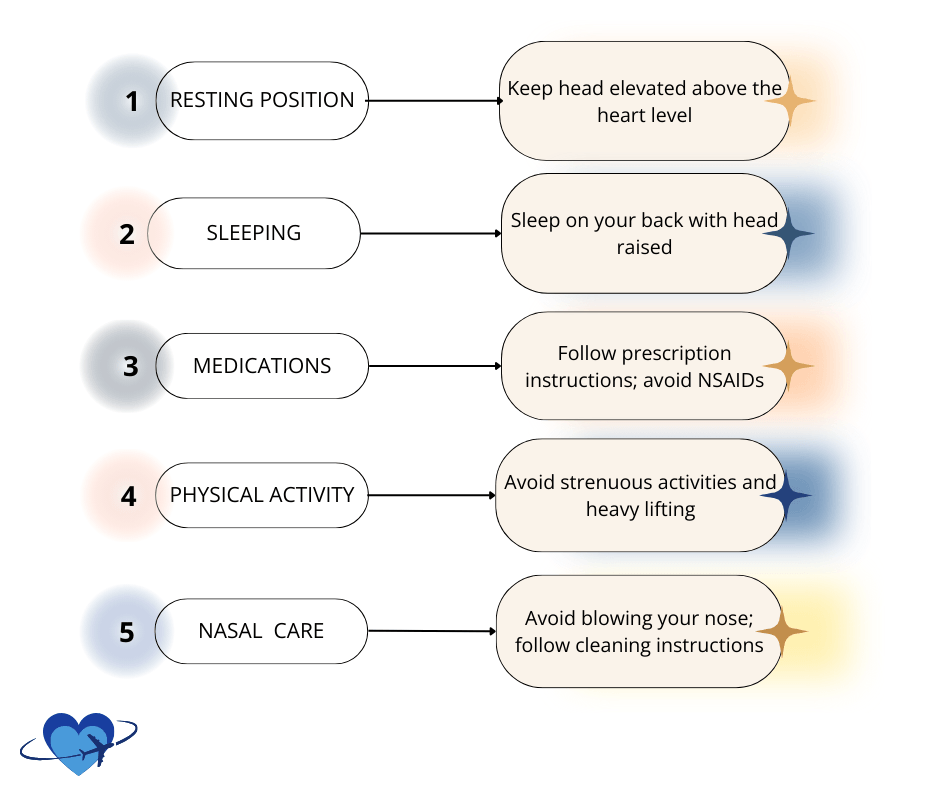
Most patients report increased self-confidence after surgery. Surgeons in Bogotá and Medellín aim for natural-looking results. Keep realistic expectations about what surgery can achieve.
What Aesthetic Improvements Can You Expect?
You can expect aesthetic improvements including better symmetry and proportions. The nose will look more balanced with your face. Surgeons adjust size, shape, and angle to match your goals.
What Functional Improvements Can You Expect?
You can expect functional improvements in breathing. Surgery fixes deviated septums and nasal blockages. Better airflow leads to improved sleep and reduced snoring.
What Psychological Benefits Can You Expect?
You can expect psychological benefits including higher self-confidence. Many patients feel better about their appearance after surgery. This often leads to improved social interactions and well-being.
How Do You Prepare for Surgery?
You can prepare for surgery by completing medical evaluations first. This includes blood tests and a medical history review. Stop smoking well before surgery. Arrange for someone to help you during initial recovery.
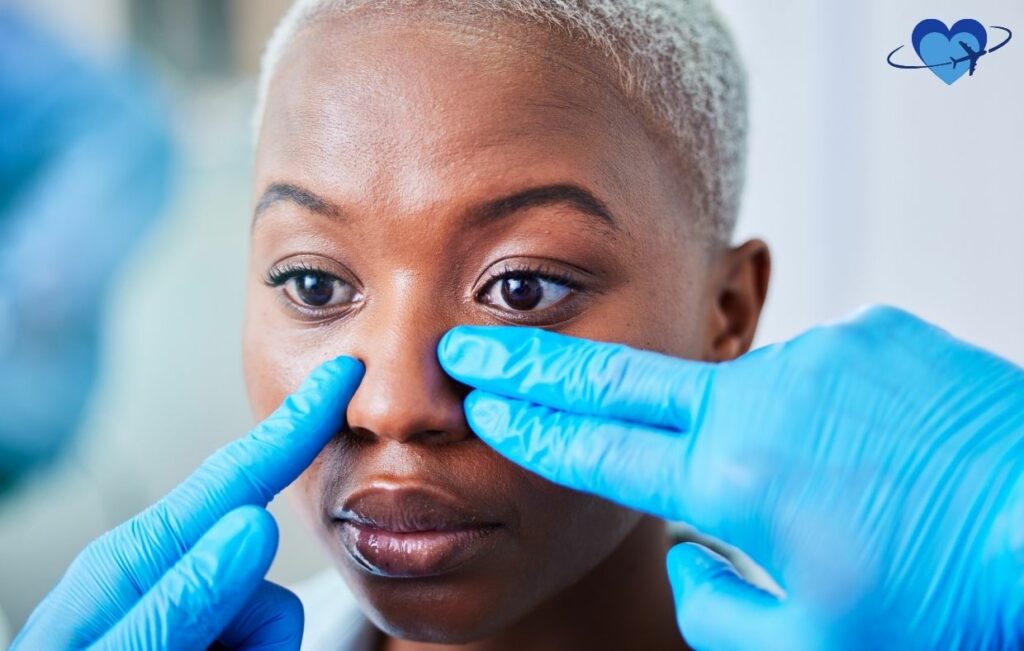
Patient receiving post-surgery care after rhinoplasty (nose job) in Colombia, showcasing expert care for optimal results.
Avoid aspirin and anti-inflammatory drugs before surgery. These increase bleeding risk. Follow your surgeon’s fasting instructions the night before.
What Medical Tests Are Required?
The medical tests required include blood work and sometimes imaging. Blood tests check for conditions that could affect surgery. X-rays or MRI scans may be needed to examine your nasal structure.
What Lifestyle Changes Are Needed?
The lifestyle changes needed include quitting smoking and reducing alcohol. Smoking slows healing and increases complications. Eat a healthy diet and stay hydrated before and after surgery.
What Are the Pre-Operative Instructions?
The pre-operative instructions cover medications, diet, and logistics. Stop certain supplements that increase bleeding. Fast from midnight before your surgery. Arrange transportation home from the clinic.
How Do You Select a Surgeon in Colombia?
You can select a surgeon by verifying credentials and reviewing their work. Look for board certification from SCCP. Check memberships in ASPS or ISAPS. Review before-and-after photos of similar cases.
Read patient reviews on RealSelf. Schedule a consultation in Bogotá or Medellín. Ask about their experience with your specific procedure type. A good surgeon will be honest about what’s achievable.
For detailed travel planning, see our guide for American medical tourists in Colombia.
What Should You Look for When Evaluating a Surgeon?
You should look for certification, experience, and communication skills. Here’s a checklist:
| Criteria | Description | Questions to Ask |
| Board Certification | Verify the surgeon is certified in plastic or cosmetic surgery. | “Are you board-certified, and by which board?” |
| Educational Background | Confirm the surgeon’s education in plastic or cosmetic surgery. | “Where did you receive your medical and specialty training?” |
| Experience and Specialization | Assess the surgeon’s experience specifically with rhinoplasty procedures. | “How many rhinoplasty surgeries have you performed?” |
| Patient Reviews and Testimonials | Look for feedback from previous patients to gauge satisfaction and success rates. | “Can you provide patient testimonials or direct me to where I can find them?” |
| Before-and-After Photos | Review the surgeon’s portfolio of past procedures to evaluate skill and aesthetic outcomes. | “Do you have a portfolio of before-and-after photos I can review?” |
| Communication Skills | Ensure the surgeon can clearly explain the procedure, risks, and recovery expectations. | “How do you handle patient questions or concerns post-surgery?” |
| Realistic Expectations | The surgeon should provide a realistic outlook on the surgery’s outcomes. | “What results can I realistically expect from my rhinoplasty?” |
| Surgical Facility Accreditation | The facility where the surgery will be performed should be accredited and meet safety standards. | “Is the surgical facility accredited, and by which organization?” |
How Do You Travel to Colombia for Surgery?
You can travel to Colombia by flying into Bogotá, Medellín, Cali, or Cartagena. US, Canadian, and EU citizens can enter without a visa for up to 90 days. For longer stays, consider the Type V medical visa.
Book flexible flights in case your surgery date changes. Choose accommodations near your clinic or use a recovery house. Plan to stay 10-14 days for surgery and initial recovery.
Are There Patient Testimonials?
Yes, there are patient testimonials from people who had rhinoplasty in Colombia. Patients report positive experiences with surgeons in Bogotá and Medellín. Most describe natural-looking results and professional care.
What Do Patients Say About Their Experience?
Patients say their experience exceeded expectations. Many report immediate improvements in appearance and self-esteem. The recovery process is well-supported in Colombian clinics. Results continue improving over months.
Can You See Before-and-After Photos?
Yes, you can see before-and-after photos from surgeons in Bogotá, Medellín, and Cali. These galleries show real patient results. They demonstrate the natural-looking outcomes skilled surgeons achieve. Ask your surgeon for examples similar to your case.

Combine Rhinoplasty with Other Facial Procedures
Many patients combine rhinoplasty with complementary facial procedures for balanced results:
- Blepharoplasty (Eyelid Surgery) – Rejuvenate tired-looking eyes
- Chin Augmentation – Balance facial proportions
- Facelift – Complete facial rejuvenation
Frequently Asked Questions About Rhinoplasty in Colombia
How Much Does Rhinoplasty Cost in Colombia?
Rhinoplasty in Colombia costs $2,000-$4,000 for primary procedures. The price depends on complexity, surgeon experience, and the clinic location in Bogotá or Medellín.
What Surgery Is Colombia Known For?
Colombia is known for cosmetic surgery, especially rhinoplasty. Surgeons in Bogotá pioneered ultrasonic rhinoplasty techniques. The country attracts thousands of international patients for nose jobs and body contouring procedures.
What Are the Qualifications of Surgeons in Colombia?
The qualifications of surgeons in Colombia include board certification and specialized training. Look for SCCP membership and 4-5 year residencies in plastic surgery. Many hold international certifications from ASPS and ISAPS.
How Long Does Recovery Take in Colombia?
Recovery takes 1-2 weeks for normal activities. Most swelling subsides within 2 weeks. Complete healing and final results appear within 12 months. Plan to stay in Colombia for 10-14 days.
What Are the Risks of Rhinoplasty in Colombia?
The risks of rhinoplasty include infection, bleeding, and anesthesia reactions. Some patients experience dissatisfaction with results. About 5-15% need revision surgery. Choosing a board-certified surgeon minimizes these risks.
How Do Costs Compare to Other Countries?
Costs compare favorably to other countries. Colombia saves you 50-70% versus US prices. A $2,000-$4,000 nose job in Bogotá costs $8,000-$15,000 in the US. Quality remains comparable to American and European standards.
What Results Should You Expect?
You should expect a reshaped nose that fits your face naturally. Results include better facial balance and improved breathing. Surgeons in Colombia aim for natural-looking outcomes that match your goals.
Can You Combine Surgery with Vacation?
Yes, you can combine surgery with vacation in Colombia. Many patients extend their stay in Bogotá, Medellín, or Cartagena. Plan 10-14 days total for surgery, recovery, and sightseeing.
What If You Need Revision Surgery?
If you need revision surgery, it’s available at reduced cost within 12 months. Most surgeons offer discounts for touch-ups. With a 95% satisfaction rate, most patients don’t need revisions.
Is Surgery Abroad Safe?
Yes, surgery abroad is safe when you choose certified surgeons and accredited facilities. Colombian clinics follow international safety standards. All surgeons are board-certified and many trained internationally. You get 24/7 patient support.
What About Language Barriers?
Language barriers are not a problem at most clinics in Bogotá and Medellín. Patient coordinators speak fluent English. Surgeons have medical English proficiency. You’ll have clear communication throughout your care.
Ready to Start Your Rhinoplasty Journey?
Medical Tourism Packages coordinates your entire rhinoplasty journey in Colombia. We connect you with board-certified plastic surgeons in Bogotá, Medellín, and Cali. Our team arranges travel, accommodations, and provides bilingual support throughout your stay.
Contact us today for a free consultation and personalized quote.


